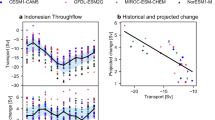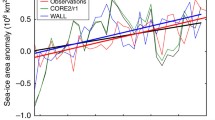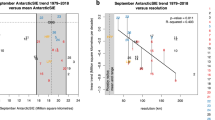Abstract
Using the set of simulations performed with atmosphere-ocean general circulation models (AOGCMs) for the Fourth Assessment Report of the Intergovernmental Panel on Climate Change (IPCC AR4), the projected regional distribution of sea ice for the twenty-first century has been investigated. Averaged over all those model simulations, the current climate is reasonably well reproduced. However, this averaging procedure hides the errors from individual models. Over the twentieth century, the multimodel average simulates a larger sea-ice concentration decrease around the Antarctic Peninsula compared to other regions, which is in qualitative agreement with observations. This is likely related to the positive trend in the Southern Annular Mode (SAM) index over the twentieth century, in both observations and in the multimodel average. Despite the simulated positive future trend in SAM, such a regional feature around the Antarctic Peninsula is absent in the projected sea-ice change for the end of the twenty-first century. The maximum decrease is indeed located over the central Weddell Sea and the Amundsen–Bellingshausen Seas. In most models, changes in the oceanic currents could play a role in the regional distribution of the sea ice, especially in the Ross Sea, where stronger southward currents could be responsible for a smaller sea-ice decrease during the twenty-first century. Finally, changes in the mixed layer depth can be found in some models, inducing locally strong changes in the sea-ice concentration.












Similar content being viewed by others
Notes
In the GISS-AOM the mixed layer depth is determined as the shallowest depth where the bulk Richardson number is equal to the critical value (0.3). Bulk Richardson numbers are evaluated by computing velocity and buoyancy differences between values at the investigated level and at the ocean surface. In the CNRM-CM3 model the mixed layer depth is defined as the depth of the highest level where the difference between the potential density of this level and the surface density exceeds 0.01 kg m−3.
The location of the ACC has been calculated as in Fyfe and Saenko (2006).
References
Arblaster JM, Meehl GA (2006) Contributions of external forcings to southern annular mode trends. J Clim 19:2896–2904
Arzel O, Fichefet T, Goosse H (2006) Sea-ice evolution over the twentieth and twenty-first centuries as simulated by current AOGCMs. Ocean Model 12:401–415
Bi D, Budd WF, Hirst AC, Wu X (2001) Collapse and reorganisation of the Southern Ocean overturning under global warming in a coupled model. Geophys Res Lett 28 20:3927–3930
Bitz CM, Gent PR, Woodgate RA, Holland MM, Lindsay R (2006) The influence of sea ice on ocean heat uptake in response to increasing CO2. J Clim 19:2437–2450
Cavalieri D, Parkinson C, Vinnikov K (2003) 30-year satellite record reveals contrasting Arctic and Antarctic decadal sea-ice variability. Geophys Res Lett 30(18):1970
Cunningham SA, Alderson SG, King BA, Brandon MA (2003) Transport and variability of the Antarctic Circumpolar Current in Drake Passage. J Geophys Res 108:8084. doi:10.1029/2001JC001147
Flato GM (2004) Sea-ice and its response to CO2 forcing as simulated by global climate models. Clim Dyn 23:229–241. doi:10.1007/s00382-004-0436-7
Flato GM, Boer GJ (2001) Warming asymmetry in climate change simulations. Geophys Res Lett 28(1):195–198
Fyfe JC, Saenko OA (2005) Human-induced change in the Antarctic Circumpolar Current. J Clim 18:3068–3073
Fyfe JC, Saenko OA (2006) Simulated changes in the extratropical southern hemisphere winds and currents. Geophys Res Lett 33:L06701. doi:10.1029/2005GL025332
Fyfe JC, Boer GJ, Flato GM (1999) The Arctic and Antarctic oscillations and their projected changes under global warming. Geophys Res Lett 26:1601–1604
Gong D, Wang S (1999) Definition of Antarctic Oscillation Index. Geophys Res Lett 26(4):459–462
Goosse H, Renssen H (2001) A two-phase response of the Southern Ocean to an increase in greenhouse gas concentrations. Geophys Res Lett 28(18):3469–3472
Gordon AL, Huber BA (1990) Southern ocean winter mixed layer. J Geophys Res 95(C7):11655–11672
Holland MM, Bitz CM, Hunke EC (2005) Mechanisms forcing an Antarctic dipole in simulated sea ice and surface ocean conditions. J Clim 18:2052–2066
Houghton J, Ding Y, Griggs D, Noguer M, van der Linden P, Dai X, Maskell K, Johnson C (2001) IPCC: Climate change 2001: the scientific basis. Contribution of workings group I to the third assessment report of the intergovernmental panel on climate change. Cambridge University Press, Cambridge, pp 881
Kwok R, Comiso J (2002) Spatial patterns of variability in Antarctic surface temperature: Connections to the Southern Hemisphere Annular Mode and the Southern Oscillation. Geophys Res Lett 29(14):1705
Lefebvre W, Goosse H (2007) An analysis of the atmospheric precesses driving the large-scale winter sea-ice variability in the Southern Ocean. J Geophys Res. doi:10.1029/2006JC004032 (submitted)
Lefebvre W, Goosse H, Timmermann R, Fichefet T (2004) Influence of the Southern Annular Mode on the sea ice–ocean system. J Geophys Res 109: C09005. doi:10.1029/2004JC002403
Liu J, Martinson DG, Yuan X, Rind D (2002) Evaluating Antarctic sea ice variability and its teleconnections in global climate models. Int J Climatol 22:885–900. doi:10.1002/joc.770
Liu J, Curry J, Martinson D (2004) Interpretation of recent Antarctic sea-ice variabilty. Geophys Res Lett 31:L02205. doi:10.1029/2003GL018732
Manabe S, Stouffer R, Spelman M, Bryan K (1991) Transient responses of a cloupled ocean-atmosphere model to gradual changes of atmospheric CO2. Part I: Annual mean response. J Clim 4:785–818
Manabe S, Spelman M, Stouffer R (1992) Transient responses of a coupled ocean-atmosphere model to gradual changes of atmospheric CO2. Part II: Seasonal response. J Clim 5:105–126
Marshall GJ, Stott PA, Turner J, Connolley WM, King JC, Lachlan-Cope TA (2004) Causes of exceptional atmospheric circulation changes in the Southern Hemisphere. Geophys Res Lett 31:L14205. doi:10.1029/2004GL019952
Marshall GJ, Orr A, van Lipzig NPM, King JC (2006) The impact of a changing Southern Hemisphere Annular Mode on Antarctic Peninsula summer temperatures. J Clim 19(20):5388–5404
Mo KC (2000) Relationships between low-frequency variability in the Southern Hemisphere and sea surface temperature anomalies. J Clim 13:3599–3610
Nakicenov N, Swart R (2000) Special report on emissions scenarios. Cambridge University Press, Cambridge, pp 599
Parkinson CL, Vinnikov KY, Cavalieri DJ (2006a) Evaluation of the simulation of the annual cycle of Arctic and Antarctic sea-ice coverages by 11 major global climate models. J Geophys Res 111:C07012. doi:10.1029/2005JC003408
Parkinson CL, Vinnikov KY, Cavalieri DJ (2006b) Correction to Evaluation of the simulation of the annual cycle of Arctic and Antarctic sea ice coverages by 11 major global climate models. J Geophys Res 111:C12009. doi:10.1029/2006JC003949
Rayner N, Parker D, Horon E, Folland C, Alexander L, Rowell D, Kent E and Kaplan A (2003) Global analyses of sea surface temperature, sea ice and night marine air temperature since the late nineteenth century. J Geophys Res 108(D14):4407. doi:10.1029/2002JD002670
Russell JL, Stouffer RJ, Dixon KW (2006) Intercomparison of the Southern Ocean circulations in IPCC coupled model control simulations. J Clim 19:4560–4574
Snedecor GW, Cochran WG (1971) Méthodes statistiques, original title: statistical methods, 6th edn by The Iowa State University Press, Ames, Iowa, USA, 67-21577, traduit par H. Boelle et E. Camhaji, Association de Coordination Technique Agricole, Paris, pp 649
Thompson DWJ, Solomon S (2002) Interpretation of recent southern hemisphere climage change. Science 296:895–899
Thompson DWJ, Wallace JM, Hegerl GC (2000) Annular modes in the extratropical circulation. Part II: Trends. J Clim 13:1018–1036
Vinnikov KY, Cavalieri DJ, Parkinson CL (2006) A model assessment of satellite observed trends in polar sea-ice extents. Geophys Res Lett 33:L05704. doi:10.1029/2005GL025282
Yuan X, Martinson DG (2000) Antarctic sea ice extent variability and its global connectivity. J Clim 13:1697–1717
Yuan X, Martinson DG (2001) The Antarctic dipole and its predictability. Geophys Res Lett 28(18):3609–3612
Zwally HJ, Comiso JC, Parkinson CL, Cavalieri DJ, Gloersen P (2002) Variability of Antarctic sea ice 1979–1998. J Geophys Res 107:C5, doi:10.1029/2000JC000733
Acknowledgments
This study is supported by the Federal Science Office (Belgium). H. Goosse is Research Associate with the Belgian National Fund for Scientific Research. We acknowledge the international modelling groups for providing their data for analysis, the Program for Climate Model Diagnosis and Intercomparison (PCMDI) for collecting and archiving the model data, the JSC/CLIVAR Working Group on Coupled Modelling (WGCM) and their Coupled Model Intercomparison Project (CMIP) and Climate Simulation Panel for organizing the model data analysis activity, and the IPCC WG1 TSU for technical support. The IPCC Data Archive at Lawrence Livermore National Laboratory is supported by the Office of Science, US Department of Energy. This work was conducted within the European project ENSEMBLES (ENSEMBLE-based Predictions of Climate Changes and their Impacts). The authors also want to thank X. Fettweis, A. de Montéty and J. Adam for their help with this manuscript.
Author information
Authors and Affiliations
Corresponding author
Rights and permissions
About this article
Cite this article
Lefebvre, W., Goosse, H. Analysis of the projected regional sea-ice changes in the Southern Ocean during the twenty-first century. Clim Dyn 30, 59–76 (2008). https://doi.org/10.1007/s00382-007-0273-6
Received:
Accepted:
Published:
Issue Date:
DOI: https://doi.org/10.1007/s00382-007-0273-6




